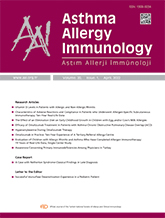


Objective: Allergic rhinitis and allergic asthma are the most common chronic diseases in children. Allergen immunotherapy has also been shown to improve symptoms and medication scores in patients with allergic rhinitis and/or asthma. In our study, it was aimed to evaluate the patients who have completed allergen immunotherapy in terms of clinical improvement and new allergic sensitizations in the skin prick test.
Materials and Methods: Patients who received allergen immunotherapy between 1999 and 2018 were included in the study. Age, sex, diagnosis, medications, sensitizations in the first skin test, immunoglobulin E level, eosinophil count, allergen immunotherapy content and duration, and time after the end of immunotherapy were recorded from patient files. It was asked from the patients to compare their clinical findings before and after allergen immunotherapy as the same, better, or worse. Skin prick tests were performed with inhalant allergens in all patients.
Results: A total of 154 patients were included in the study, 68 of whom were subcutaneous and 86 were sublingual immunotherapy. Age, sex, disease severity, immunoglobulin E levels, and eosinophil counts of patients were similar in the subcutaneous and sublingual immunotherapy groups. In the subcutaneous immunotherapy group, self-reported clinical improvement for allergic rhinitis and asthma were 53.3% and 60.4%, respectively. In the sublingual immunotherapy group, self-reported clinical improvement for allergic rhinitis and asthma were 61.9% and 61.6%, respectively. New sensitization in the subcutaneous immunotherapy group was 12.1% and it was 3.5% in the sublingual immunotherapy group.
Conclusion: More than half of our patients who received immunotherapy reported clinical improvement according to self-report. In the subcutaneous immunotherapy group, new sensitizations were higher than the sublingual immunotherapy group, but it was thought that longer follow-up time in the subcutaneous immunotherapy group may have also contributed to this result.